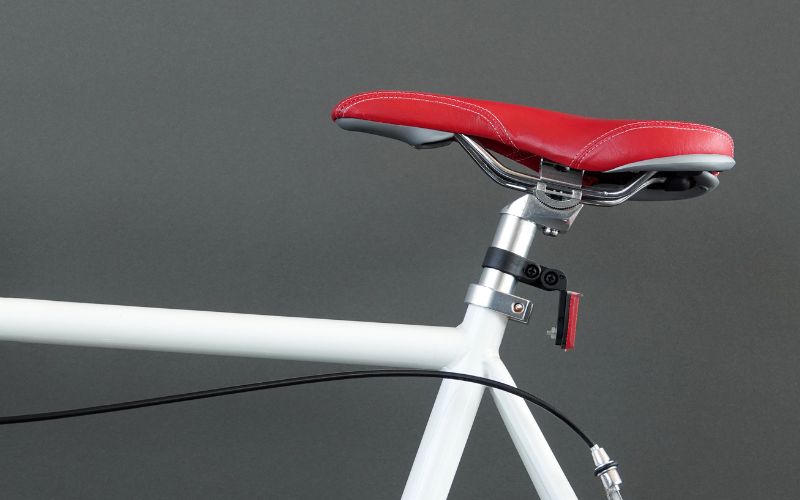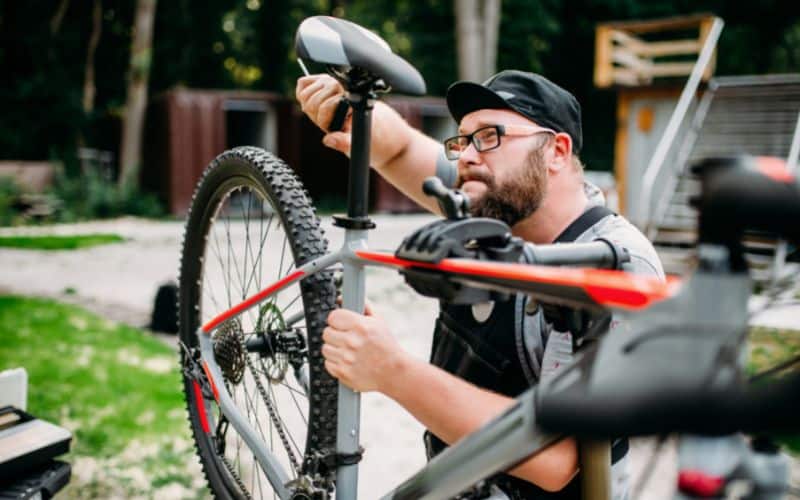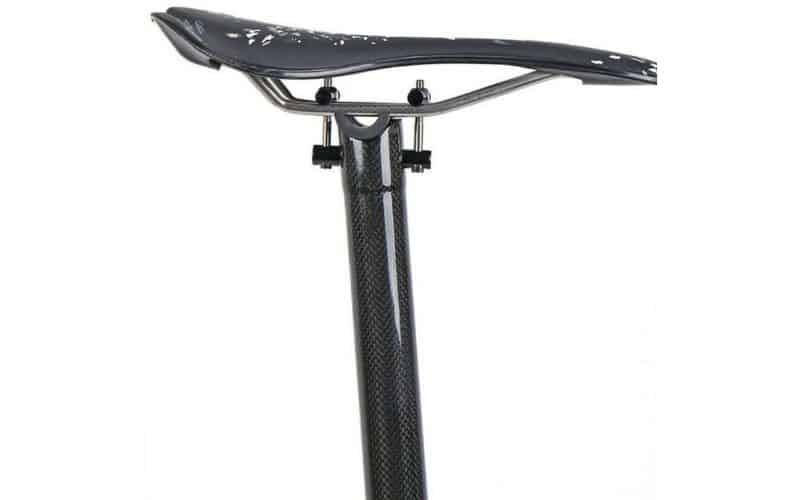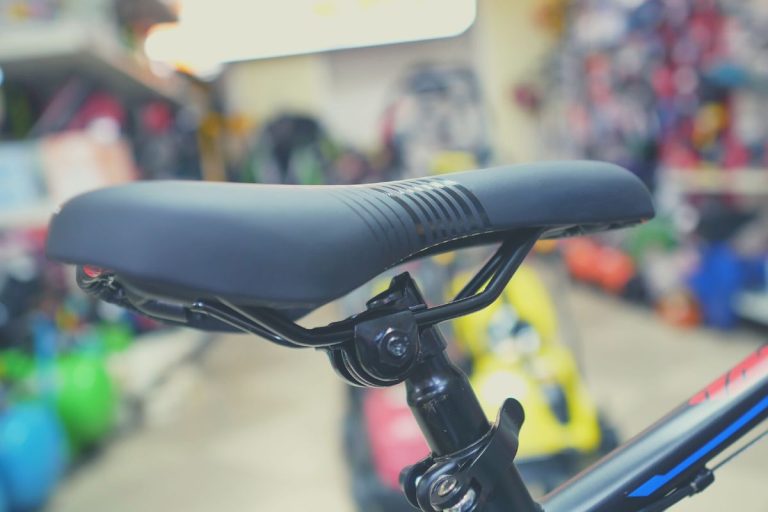There is not much more annoying than getting everything ready for a ride only to discover the bike seat is wobbling, tilting, or sliding down. I remember the bike ride where I was left stranded on a trail shouting at the sky, “Why does my bike seat keep coming loose?”
It was the first time I was about to ride solo without a toddler in a Burley towed behind. I made sure everything was ready. So I thought! My one mistake was assuming the seat was still in position.
When I hit the trail, I started to lose my balance as the seat slipped, wobbled, and nearly threw me off. Thankfully, I was able to remedy the issue without losing my balance and toppling over me or a previously in-tow child relying on my bike-riding skills.
Not to be the bearer of bad news, but not every cyclist is so lucky. According to the CDC, nearly 130,000 cyclists are injured every year along with 1,000 who don’t live to tell about it. Some of these accidents are bound to be the result of a loose seat.
Why Does My Bike Seat Keep Coming Loose?
The most common reason for a bike seat coming loose is a loose bolt or fitting. This can happen because of dirt and grime building up, because it’s the wrong size post, or because the bolt isn’t tightened enough or has become stripped.
If you ride frequently, it’s bound to happen to you too. Maybe it’s in the middle of a wooded trail or on a competitive ride that keeps you from being the winner. Regardless of where it happens, it’s more than a nuisance. A loose bicycle seat could become dangerous, throwing you off balance and causing a wreck.
Related article – How To Make Your Bike Seat More Comfortable
How Is The Bike Seat Held In Place?
To understand why my bike seat keeps coming loose and how to fix it, it helps to completely understand how the seat is designed to hold in place. Basically, there are three main parts:
- Seat post
- Seat Tube
- Clamp or bolts
If any of these parts are not secured properly, the seat will begin to come loose.

How To Fix A Loose Bike Seat
Tighten The Seat Post Clamp
The clamp holds the seat post in place by tightening it around the seat tube. The clamp is either a bolt style or a quick release.
Quick Release Clamps
A quick-release style of clamp is very convenient since it doesn’t require the use of any special tool to adjust. You can easily stop and adjust the seat in the middle of a ride even if you forgot to bring along a wrench.
If the clamp cannot tighten against the post and seat tube, the seat will begin to slip once you put weight on it.
The adjustment knob is usually located on the opposite side of the lever. To tighten the seat, all you have to do is turn the adjustment knob clockwise and then secure it. However, if you tighten the knob too much, the lever won’t close. Sometimes, the lever will wear out and need to be replaced.
Bolt Style Clamps
Bolt-style clamps are more reliable and hold the seat post in place well once tightened. At least that’s the idea when the bolt is working properly!
Sometimes the bolt becomes stripped due to over-tightening. Or, the bolt can crack and needs to be replaced.
Interesting read – Why Do Bike Seats Have A Hole In Them?

Make Sure The Seat Post Fits Properly
One reason for a loose-fitting seat is a seat post that won’t stay in place. A seat post is supposed to fit the frame and slide smoothly into the seat tube without any side-to-side movement or play. If the post is slightly off, it could make all the difference between a tight-fitting seat and one that keeps sliding down.
As odd as it may sound, the best way to keep the post from sliding is to apply grease. Make sure all connections are clean, and then apply a thin coat of grease inside the seat tube. The grease will actually help the seat post grip and stay where you set it.
The grease will also help to prevent corrosion that would eventually cause the seat post to stick inside the frame and not be able to be adjusted at all.
If your seat post and bicycle frame are steel, titanium, or aluminum, use standard bicycle grease. If any part is made out of carbon fiber, never use grease. Instead of grease, use a carbon assembly paste.
Otherwise, you may have a science experiment gone wrong with the oil-based, petroleum chemicals from the grease reacting with the carbon fiber making the parts continuously slip and not grip.
Keep in mind that grease should never be used with carbon fiber parts, but the opposite works well. Carbon assembly paste, which usually contains silicone particles that create friction, can be used on metal parts that are stuck or prone to slipping.
Related article – Bike Geometry Explained – What Does It Mean?

Tilting Seat
Seats don’t just slip or wobble up and down. Sometimes, a tilting seat is a problem. It can shift you forward or backward at an unexpected angle. This is a problem that can be especially dangerous in the middle of an intense ride.
Tilting is usually caused by the clamp at the top of the seat post that needs to be tightened. Some have a smooth clamp surface, and others have a micro-adjustment, a small knob to make precise adjustments. Others have a serrated surface that resembles teeth that lock in place. If the teeth become worn down, you may need a new seat post.
If you have tightened the bolts and are still having issues with the seat tilting, it’s time to take apart the clamp, remove the seat, and clean off any grime or grease that has built up. Examine the pieces to make sure nothing is cracked or stripped.
Once it is cleaned, apply grease on the bolt threads and anywhere metal comes into contact with metal. Re-assemble the pieces, adjust the seat, and tighten.
Clamps and Seat Post Sizing
Of course, seat posts are not a standard size. The diameter of the seat post is measured using millimeters. The seat post size must match the inside diameter of the seat tube on the frame.
If it’s even off by 1/10 of a millimeter, it will be difficult to secure the seat to stay in place. Some of the most common sizes are:
- 27.2mm
- 30.6mm
- 31.6mm
Seat posts are also measured in length. Most are marked with a “Minimum Insertion Point” which means that the seat post must be installed with the part below the minimum mark within the seat tube in the frame. If you don’t follow this guideline, you could crack the bike frame or risk injuring yourself while riding.
The seat post diameter must match the outside diameter of the seat tube on the frame. Seat post clamps are measured in millimeters by diameter. The seat post clamp diameter is not always the same for all bikes that fit the same size of the seat post. This is due to the outside diameter of the frame varying depending on the thickness of the material that is used for the frame tube.
Need some more help? Check out this video:
Related article – How To Maintain Your Bike – Essential Maintenance Tips
Proper Maintenance Prevents Wobbly Seats
Try saying that fast a few times!
Every so often:
- Remove the seat post from the frame
- Wipe off old grease with a cloth
- Push the cloth down into the frame to clean the grease from inside the seat tube
- Use a brush to apply a thin coat of fresh grease to both the inside of the seat tube and the outside of the seat post
Hopefully, that helps you resolve your loose bike seat. Keep safe and ride on!
Related article – Best Bike Tool Kit For DIY Maintenance

